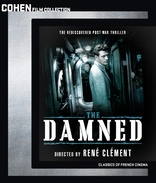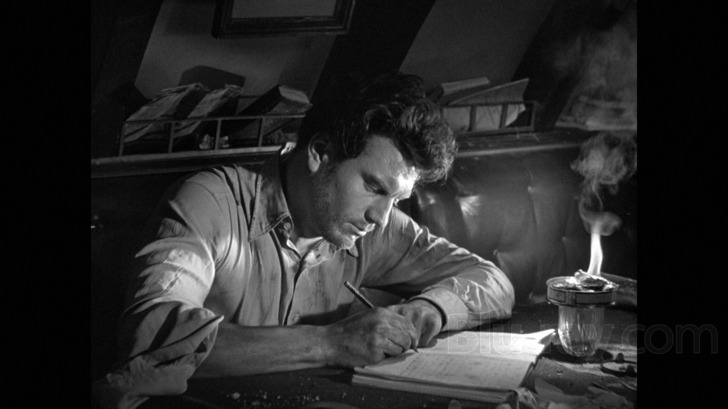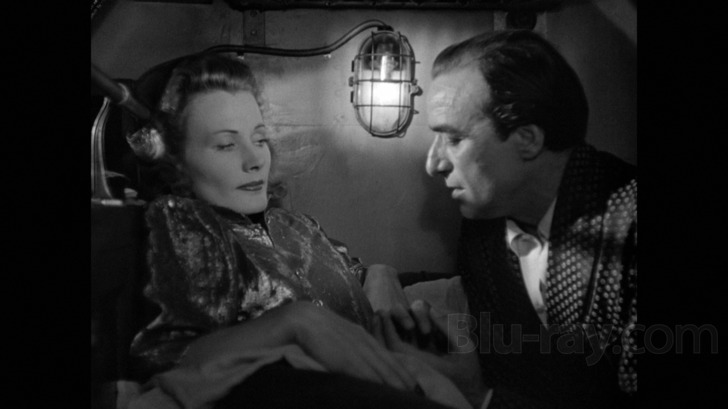The Damned Blu-ray Movie 
Les MauditsCohen Media Group | 1947 | 105 min | Not rated | Aug 13, 2013

Movie rating
|
| 7 | / 10 |
Blu-ray rating
| Users | 3.5 | |
| Reviewer | 4.0 | |
| Overall | 3.7 |
Overview click to collapse contents
The Damned (1947)
Oslo, April 19th 1945, as the Third Reich is living its last day, a group of Nazis and sympathizers (a Wehrmacht general, an SS leader and his "assistant", an Italian industrialist and his wife who is also the general's lover, a French collaborator) board a submarine that will take them to South America, where they hope to find shelter. While they sail off the shores of liberated Royan they manage to kidnap a French doctor to have him look after a wounded passenger. Dr Guilbert will be forced to share the restricted space of the submarine with the fugitives. The atmosphere soon becomes unbreathable...
Starring: Marcel Dalio, Henri Vidal, Florence Marly, Paul Bernard (I), Michel AuclairDirector: René Clément
| War | Uncertain |
| Drama | Uncertain |
Specifications click to expand contents
Video
Video codec: MPEG-4 AVC
Video resolution: 1080p
Aspect ratio: 1.33:1
Original aspect ratio: 1.37:1
Audio
French: LPCM 2.0
Subtitles
English
Discs
50GB Blu-ray Disc
Single disc (1 BD)
Playback
Region A, B (C untested)
Review click to expand contents
Rating summary
| Movie | 4.5 | |
| Video | 3.5 | |
| Audio | 3.5 | |
| Extras | 3.0 | |
| Overall | 4.0 |
The Damned Blu-ray Movie Review
Submarine of Fools.
Reviewed by Jeffrey Kauffman August 10, 2013Despite the fact that he experienced considerable success over a fairly long career, including bring home two Academy Awards for Best Foreign Language film, René Clément is often strangely overlooked when “great French directors” are discussed. For some reason the immediate post-World War II era, when Clément crafted some of his most powerful pieces, is almost like a cinematic twilight zone for analysts of French film. The titans of a previous generation like Jean Renoir seemed to have either lost some of their creative mojo or actually left the French scene altogether (as Renoir did for a time), and the upstarts of the Nouvelle Vague movement were still in knee socks (and it's no great secret that François Truffaut, one of the leading members of that movement, despised Clément’s films). But Clément’s contributions to French cinema are inarguable, including his stirring 1945 homage to the French Resistance, La Bataille du Rail (The Battle of the Rails) as well as his two Oscar winners, 1950’s The Walls of Malapaga, a star-crossed love story starring Jean Gabin (actually released in France in 1949, and still very hard to find to this day) and especially 1952’s Jeux Interdits (known internationally as Forbidden Games), a stinging indictment of the trauma war inflicts on children. Clément may unfortunately be best remembered by younger filmgoers or those with shorter memories for the bloated 1966 international “epic” Is Paris Burning?, another attempt to obviously portray France’s role in World War II, but for those who associate Clément with this well intentioned but overblown film, a look at his earlier, leaner work is highly recommended. That includes his little seen The Damned (in French Les Maudits), which debuted over the course of several months from late 1947 to spring 1948 in international markets. While the film was generally well received in its day, it was perhaps ill timed in its depiction of a gaggle of defeated Nazis and their sympathizers attempting to escape the ruins of war torn Europe in a submarine bound for South America.

The Damned plays almost like a flip side to Katherine Anne Porter’s famous 1962 novel Ship of Fools (later made into a film). Where Porter’s story grouped together a disparate bunch of disaffected souls on their way to a pre-World War II Europe, The Damned gathers together an equally varied assortment of people fleeing the smoking ashes of the continent. A German submarine in Oslo is waiting for this gaggle of folks, which include a General named Von Hauser (Kurt Kronefeld), an SS member named Forster (Jodest), a French collaborator named Couturier (Paul Bernard), an Italian industrialist named Garosi (Fosco Giachetti) and his wife (who also happens to be the General’s mistress), Hilda (Florence Marly). Rounding out this international assortment of runaways is Ericksen (Lucien Hector) and his teenaged daughter Ingrid (Anne Campion). The goal is to get to South America, where there are agents waiting who will help them to establish new lives (with new assumed identities). As the submarine leaves, though it is in the waning days of the war, Germany has not yet surrendered and most of the passengers are still committed to fealty to the Reich.
With tensions already running high due to the cramped quarters and the varying loyalties of various groups, things become decidedly more precarious when a depth charge seems to seriously injure Hilda. The simmering conflict between Von Hauser, the professional soldier, and Forster, the civilian commandant, come to a head when Forster wants to land at a nearby port to offload the comatose woman, whom he considers “ballast”. Cooler heads prevail, though in an odd way: the decision is made to send a small scouting party to land in order to kidnap a French doctor. That hapless soul turns out to be Doctor Guilbert (Henri Vidal), who only at this point in the film is revealed to be the film’s narrator. Guilbert is abducted at gunpoint and forced to climb aboard the sub (the shot of Guilbert entering and moving through the sub is a technical marvel when one considers the lack of Steadicams back in that era), and attend to Hilda as the sub goes underwater once more and heads for sunnier (and hopefully more peaceful) climes.
Guilbert is no fool and recognizes that he is a walking dead man (“a dead man operating under a stay of execution”, as he puts it), so he begins a desperate attempt at psychological warfare, manufacturing a diphtheria “outbreak” that frightens the crew and passengers, and, later, subtly playing off the already obvious dysfunctions between various parties. He finds an unlikely ally in the ship’s radio operator, and he hopes to make his escape on a dinghy being kept in so-called “steerage”.
The sub actually manages to get to South America, but there things take an even more dour turn when their contact isn’t very receptive and in fact tries to lure Forster’s young aide Willy (Michel Auclair) to the “dark side” of those collaborating with the Allies. This sets up what is arguably the film’s most brilliant sequence, where Willy escapes into a warehouse full of sacks of coffee beans. The film has already exploited an incredibly claustrophobic feel. Even the pre-submarine sequences have found various characters completely surrounded by structures or other imposing obstacles, and here, outside of the submarine, that ambience continues, with Clément shooting the cat and mouse game from several precarious angles which only emphasize the cramped alleyways in between the sacks of coffee.
This sequence comes to a climax in a short scene worthy of the best of Hitchcock, one which I’m certain Hitchcock himself must have seen, as a central image from Psycho is in fact presaged here rather brilliantly. Willy is actually lured back by Forster without so much as a word and is then “told” (again wordlessly) to kill the ostensible South American contact. It’s one of the most incredibly well staged scenes of this era, chilling to the core despite not really showing all that much.
With no harbor afforded them in South America, the increasingly desperate people take off once again. There’s already been some attrition, with one member committing suicide, and that only increases now, though Clément is awfully cagey about at least one of the deaths, implying that Forster isn’t above killing those whose loyalty he questions. In fact the entire film is made up of a certain amount of paranoia. Early in the film various characters claim to have met others previously, but are met with stares of incomprehension or at best middling remembrance (in a kind off odd presaging of another French film, Resnais’ Last Year at Marienbad). Various people also speak a glut of different languages, and nationalistic and ethnic differences come to the fore more and more as the film progresses. Even the putative hero, Guilbert, is not above suspicion as in a moment of forgetfulness he speaks German. Was he a former collaborator? Clément reveals next to nothing throughout the film, leaving the audience in much the same state of overriding suspicion as the bulk of the characters on board the submarine.
The film becomes slightly ludicrous in its closing scenes, when Forster, realizing that all is lost (ironically after the crew finds out the war has ended), goes completely off the rails and engages in a series of patently absurd actions. It’s a small diversion in what is overall a nearly perfectly realized exercise in the changing power structures of various relationships. (Pay attention to the great scene between Forster, the proletariat civilian, and Von Hauser, the aristocratic military man, late in the film which mirrors some of the subtexts of Renoir’s great La Grande Illusion). It’s proof positive that as legendary a figure as François Truffaut was, he was inarguably wrong about Clément and his craft. Clément’s vision is firmly on display in The Damned, but the writer-director is smart enough not to spell everything out in black and white.
The Damned Blu-ray Movie, Video Quality 

Not being privy to the shape The Damned's elements were in, it's probably wise not to be too judgmental about Cohen's AVC encoded 1080p transfer in 1.33:1, for it's evident the film has undergone some substantial restoration. That said, there are a couple of consistently troubling issues that stand in the way of this receiving a higher score. The less troubling of the two problems is somewhat inconsistent contrast, which occasionally varies to fairly milky, overblown status. Much more odd are regular tonal variations that see the film morphing almost moment from moment from what I would term an accurate black and white presentation to something tinged almost toward the blue or even purple side of things. The elements simply may not have allowed for a more precise digital timing to have been done here, but the variances on display are really rather wide and not easy to ignore. All of that said, the bulk of the film looks rather good, with a crisp, mostly stable image, and above average fine detail. There are a lot of stock shots interspersed throughout the film (mostly to do with the submarine), and those understandably look a good deal more ragged than the bulk of this presentation.
The Damned Blu-ray Movie, Audio Quality 

Cohen lists the track on this Blu-ray as an uncompressed LPCM 2.0 stereo outing, but I sensed little if any stereo separation, except perhaps for some of the brief music cues. One way or the other, this track is surprisingly trouble free, without even much hiss to report. There's occasional very minor boxiness in the midrange, but dialogue is always clear, and the sound effects also resonate quite vividly. Fidelity is very good and there's reasonable dynamic range here as well, courtesy of a few explosions and gun shots.
The Damned Blu-ray Movie, Special Features and Extras 

- René Clément or The Cinema of Sketches (1080p; 54:06) is a top rate 2010 documentary by French filmmaker Dominique Maillet. This homage to Clément deals with his oddly marginalized reputation in French cinema, due in part at least somewhat to Truffaut's disparagement of him within the context of the auteur theory. This is filled with outstanding interviews, including with Costa-Gavras who considers Clément to be worthy of as much praise as other icons in the French filmmaking world. This piece gives a lot of great background on Clément and provides glimpses of several of his films.
- Theatrical Re-release Trailer (1080p; 1:37)
- On The Damned: A Conversation Between Judith Mayne and John E. Davidson. Mayne and Davidson, both Ohio State University film scholars, provide an interesting but highly intermittent commentary. Long swaths of the film go by with nary a word from them, and then they'll both chime in with some rather cogent insights, especially regarding some of Clément's framings.
The Damned Blu-ray Movie, Overall Score and Recommendation 

The Damned is a near impeccable psychological study of various people trapped in their own existential dilemma, rather reminiscent of Jean-Paul Sartre's No Escape. The film is deliberately ambiguous at virtually every step of the way, with alliances shifting seemingly with every rock of the submarine itself. The performances are pitch perfect and Clément's staging of the film is really incredible, with a number of simply unforgettable sequences. The video quality here has some problematic issues, but my hunch is the elements must have been very badly damaged, especially since this was considered a "lost" film for so long. Even with the video issues, which simply may not have been able to be overcome, this release comes Highly recommended.



















